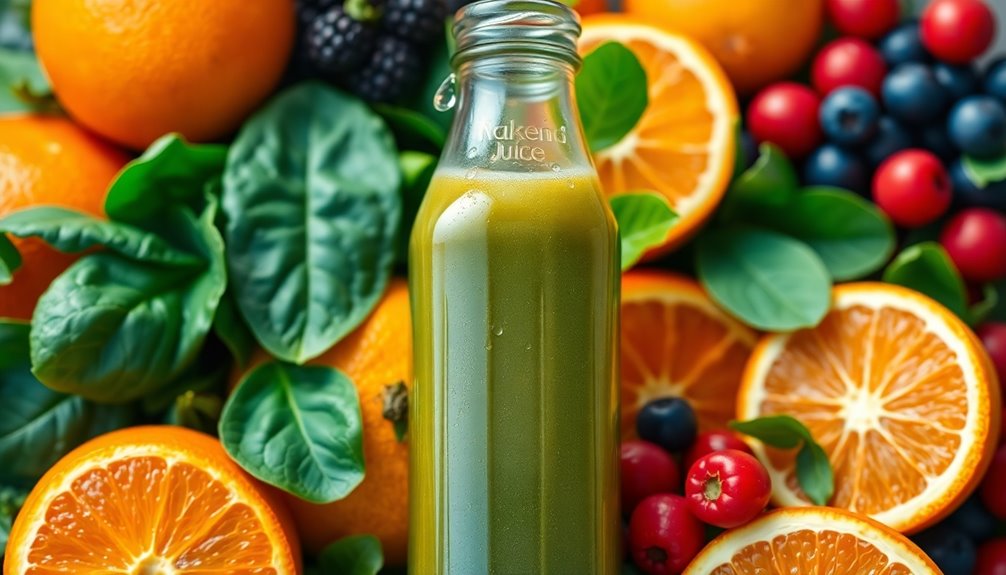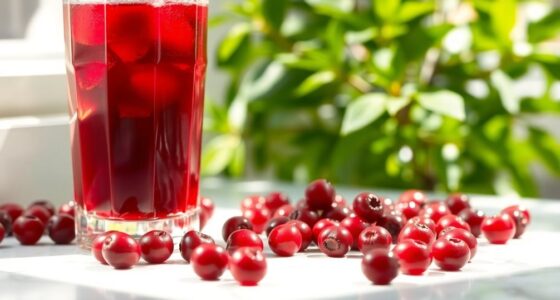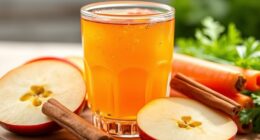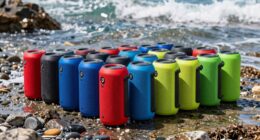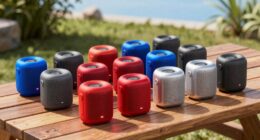Naked Juice may seem healthy, but it packs a lot of sugar—often over 76 grams per bottle. That's well above the daily limit suggested by the American Heart Association. Plus, it lacks the fiber found in whole fruits, which helps regulate blood sugar. The calories mainly come from these sugars, which can contribute to weight gain. So, while it might feel like a healthy choice, there are important factors to consider before you enjoy that next bottle.
Key Takeaways
- Naked Juice can contain over 76 grams of natural sugars per bottle, exceeding daily limits recommended by health organizations.
- The juicing process removes fiber, leading to poor blood sugar regulation and reduced satiety compared to whole fruits.
- A typical bottle has around 270 calories, primarily from sugars, which can contribute to weight gain if consumed excessively.
- Misleading marketing claims about health benefits may create false perceptions of the nutritional value of Naked Juice.
- Whole fruits offer a more balanced source of nutrients and fiber, making them a healthier choice than fruit juices.
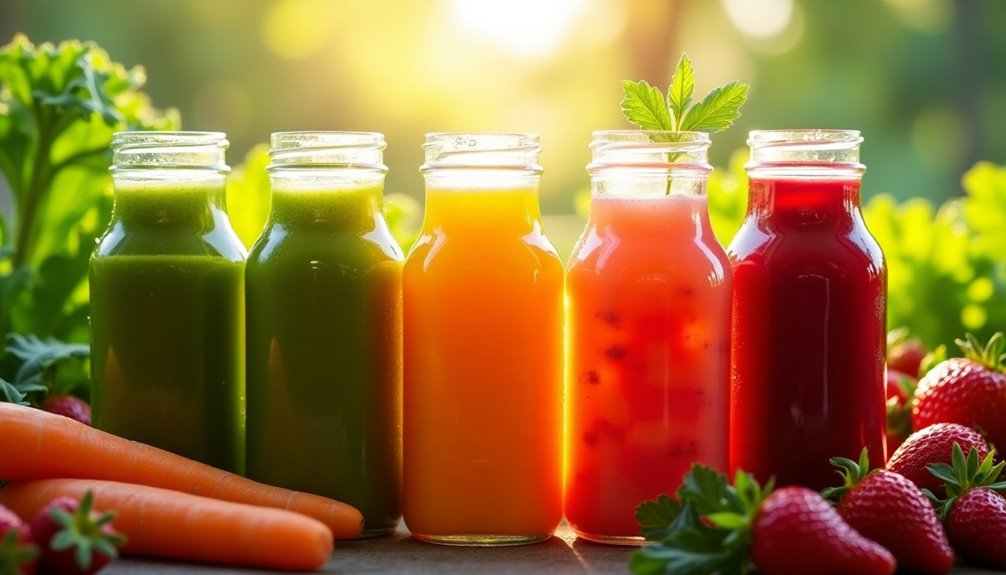
How healthy is Naked Juice really? If you're grabbing a bottle of this colorful drink, you might think you're making a healthy choice. After all, it's marketed as a nutritious option packed with vitamins and minerals, right? However, there's a lot more to the story, especially when you look closely at the sugar content. Some varieties of Naked Juice contain over 76 grams of natural sugars per bottle, which far exceeds the American Heart Association's recommended daily limit. This high sugar content can raise some red flags about how healthy these drinks actually are.
While Naked Juice does provide certain health benefits, like some vitamins and antioxidants, it lacks the fiber found in whole fruits. The juicing process strips away much of the fiber, which is crucial for regulating blood sugar levels. When you consume these juices, you're likely to experience spikes in your blood sugar, which can lead to increased insulin levels. Over time, this could contribute to weight gain and even raise your risk of developing type 2 diabetes.
So, even though you might think you're fueling your body with healthy fruits, you might be setting yourself up for some serious health issues.
Let's talk about calorie intake. A typical 15.2-ounce bottle of Naked Juice, like the Green Machine, packs around 270 calories, primarily from sugars. If you're not careful, those calories can add up quickly, especially if you enjoy these juices regularly.
While they might seem like a convenient way to get your fruits and vegetables, the reality is that consuming these drinks in excess can lead to unintended weight gain. It's essential to consider how these calories fit into your overall daily intake, particularly if you're trying to manage your weight.
Moreover, Naked Juice has faced legal scrutiny for its health claims, with accusations of misleading consumers regarding the true nutritional value of its products. Many people may assume that because it's labeled as "100% juice," it's a wholesome choice.
However, this can be deceptive. Whole fruits offer a balanced source of nutrients, including fiber, which helps you feel full and satisfied. In contrast, Naked Juice might leave you wanting more, as it doesn't provide the same level of satiety.
Frequently Asked Questions
Are Naked Juices Healthy?
When you're wondering if Naked Juices are healthy, it's important to consider their sugar content.
Many of these drinks pack in over 50 grams of sugar, which exceeds daily recommendations. They might offer some vitamins, but their low fiber means you won't feel full.
While they can be convenient, relying on whole fruits and vegetables is often a better choice for nutrients and overall health.
Moderation is key if you decide to indulge.
What Juice Is Healthiest to Drink?
What's better than sipping on a refreshing glass of nutrient-packed juice?
If you're aiming for the healthiest option, go for 100% pure fruit or vegetable juice, like fresh-squeezed orange juice or cold-pressed green juice.
Juice blends with leafy greens and fruits can also be great, providing a balance of vitamins and minerals.
Just remember, eating whole fruits and vegetables is even better for fiber and overall health!
What Is the Most Unhealthy Juice?
When you consider unhealthy juices, those with excessive sugar are at the top of the list.
Many commercial fruit juices, often marketed as healthy, contain high sugar levels that can spike your blood sugar and contribute to weight gain.
You should be wary of drinks like Naked Juice, which may seem nutritious but can pack in more sugar than soda.
Always check labels and opt for juices with lower sugar and higher fiber content.
Are Green Juices Actually Healthy?
Think of green juices as a shiny car that looks great but mightn't run well.
While they pack a punch of vitamins and antioxidants, you've gotta watch the sugar levels—53g in some cases!
Plus, juicing strips away fiber, which is essential for keeping your blood sugar stable and making you feel full.
If you're not careful, these drinks can add extra calories to your diet without the satisfaction of whole fruits and veggies.
Conclusion
In conclusion, while Naked Juice can offer a tasty way to get a boost of vitamins, it’s essential to pay attention to those sneaky sugars. You might grab a bottle thinking you’re making a healthy choice, only to find out it’s packed with more sugar than a candy bar. So, next time you reach for that vibrant juice, remember to check the label—your body will thank you for it! Balance is key, after all! Additionally, if you’re looking to incorporate more nutrients into your diet without excessive sugars, consider exploring affordable juice cleanse options. These can provide a refreshing reset for your system while still delivering essential vitamins and minerals. By choosing carefully, you can maintain a healthier balance and truly enjoy the benefits of juicing without the downside of hidden sugars.
Cindy thoroughly researches juicing trends, techniques, and recipes to provide readers with practical advice and inspiration. Her writing style is accessible, engaging, and designed to make complex concepts easy to understand. Cindy’s dedication to promoting the advantages of juicing shines through her work, empowering readers to make positive changes in their lives through the simple act of juicing.

